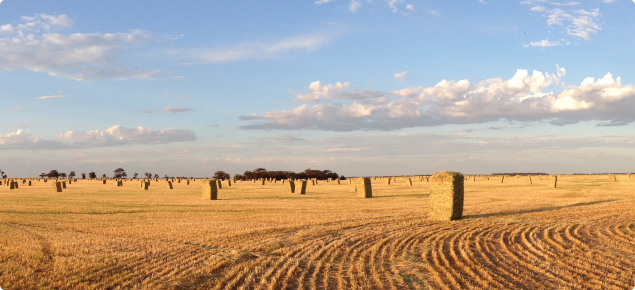Export hay
Talk to your local hay processor before sowing oats for export hay. Hay processors have different requirements which will affect how you manage your crop. Your processor can advise you about their requirements for the production of export hay.
ARGT management and testing
Look to implement an annual ryegrass toxicity (ARGT) management plan through the introduction of the twist fungus or Safeguard ryegrass. There is nil tolerance of ARGT for export and with export hay becoming a prescribed product, testing for ARGT will become compulsory. ARGT testing services are offered by the Department's Animal Health Laboratory.
Soil test
As hay crop remove substantial amounts of nutrients, it is important to soil test paddocks, particularly those where hay is regularly grown.
Seeding rate
Target 240-20 plants per square metre (110-150 kilograms per hectare (kg/ha) depending on grain size). Higher is not always better as it can lead to reduced stem thickness in inherently narrow stemmed varieties like Wintaroo. Higher seeding rates do offer better weed competition and generally lead to increase hay yield.
Variety selection
Winjardie, Carrolup, and more recently released varieties Williams, Wintaroo, Brusher, and Mulgara developed by the National Oat Breeding Program are high quality oaten hay varieties grown in Western Australia. The National Oat Breeding Program develops high quality export hay varieties, focusing on yield, quality and disease resistance improvements.
| Variety | Yield (t/ha) | Digestibility (%dm) | WSC (%dm) | ADF (%dm) | NDF (%dm) | Crude protein (%dm) |
|---|---|---|---|---|---|---|
| Bannister | 9.9 | 64.0 | 24.2 | 30.5 | 51.9 | 8.0 |
| Brusher | 9.5 | 62.7 | 26.0 | 31.8 | 52.0 | 7.7 |
| Carrolup | 8.8 | 61.2 | 25.2 | 32.7 | 52.4 | 7.6 |
| Mulgara | 9.4 | 62.3 | 25.3 | 32.8 | 52.4 | 7.9 |
| Swan | 9.8 | 61.9 | 24.4 | 33.0 | 53.5 | 7.7 |
| WA02Q302-9 | 8.0 | 63.0 | 23.8 | 33.1 | 53.2 | 7.8 |
| Wandering | 9.3 | 64.2 | 24.5 | 30.6 | 51.0 | 8.2 |
| Williams | 8.9 | 61.4 | 22.4 | 32.5 | 53.5 | 8.2 |
| Winjardie | 9.1 | 62.6 | 25.1 | 32.2 | 53.1 | 7.5 |
| Wintaroo | 10.0 | 61.5 | 23.8 | 33.2 | 53.2 | 7.7 |
| Yallara | 9.5 | 62.4 | 27.5 | 31.8 | 51.0 | 7.5 |
Paddock preparation
Roll paddocks after seeding but before the start of tillering (reduces contamination).
Potassium fertiliser
Applying potash can improve both hay yields and hay quality. Potassium can improve quality by decreasing stem fibre (acid detergent fibre (ADF) and neutral detergent fibre (NDF)) levels and in situations where inadequate nitrogen fertiliser has been applied, increase water soluble carbohydrates. Varieties may differ in their response to applied nitrogen.
Nitrogen fertiliser
Do not apply excessive levels of nitrogen as it may decrease hay quality by increasing stem fibre levels (ADF and NDF) and decreasing water soluble carbohydrates. Varieties may differ in their response to applied nitrogen.
Row spacing
Maximum row spacing for oaten hay is 180mm. This assists with keeping the hay swath off the ground.
Cutting date risk
Sowing date and variety maturity can be used to minimise the risk of all your hay being on the ground at the same time. Spreading the sowing date of a variety over a week or so; or sowing two varieties of differing maturity can reduce the risk of weather damage due to adverse weather conditions after cutting.
Disease
In high disease risk areas where a susceptible variety has been sown, early label applications of a registered fungicide may lower the impact of disease infection on the physical appearance of hay for export.
Withholding periods
Only apply registered herbicides and fungicides in accordance with the label registrations as some export markets such as Japan have recently introduced maximum residue limits (MRL) in in feed products. Do not apply a herbicide or fungicide within a withholding period before cutting.
Contractors
Talk in advance to your contractor about the suggested cutting date so that machinery is available at the crucial cutting time.
Cutting stage
Cut hay at the watery ripe stage (Z71). This usually occurs in late September to early October with a May planted crop. A later cut gives a yield advantage but quality drops. Quality may be better when cutting early but there are yield penalties. Cutting at the watery ripe stage is the best compromise between high yield and high quality. Varieties with good colour like Wintaroo need to be monitored carefully, to make sure that they are cut at the right stage.
Cutting height
Cut hay at least 15cm high. If stems are thick,cut a bit higher to reduce fibre content.
Super conditioners
The use of super conditioners can reduce the risk of weather damage by reducing the interval between cutting and baling from 10-14 days down to 4-5 days. In good drying conditions however, super conditioning can result in hay becoming too dry and make it difficult to form a good bale.
Baling
Bale when moisture has dropped to between 12-14%.
Acknowledgements
Information is reproduced from DAFWA Bulletin 4798 Growing oats in Western Australia for hay and grain, produced by Raj Malik, Blakely Paynter, CIndy Webster and Amelia McLarty.

